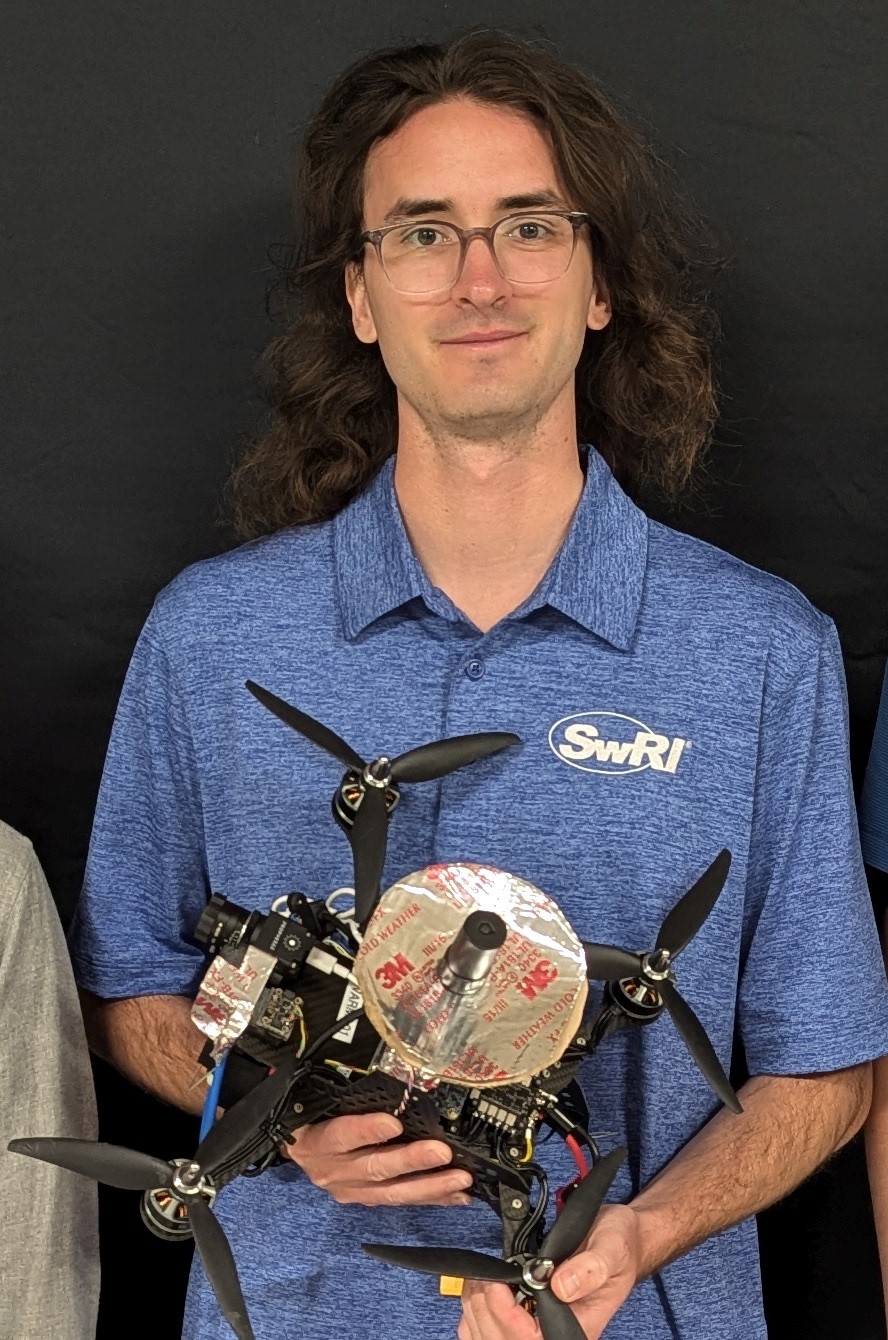Brown Bag: Autonomous UAS Exploration and Advanced Sensor Integration
The Intelligent Systems Division at SwRI has worked on a wide variety of uncrewed aerial systems (UAS) projects varying from autonomy in confined GPS denied spaces to installing sensors on transmission power lines. This talk will give an overview of the UAS projects the Robotics Department has worked on in the last few years.
A major focus has been autonomous navigation and exploration with UAS in GPS denied environments. SwRI has developed a software stack that enables exploration in indoor environments without reliance on GPS for localization. The stack has been used to explore and map the interior of a nuclear power plant, natural limestone caves in San Antonio, and a variety of warehouse buildings. The system can operate fully autonomously without any user input except a takeoff and explore command. Beyond mapping the environment, the vehicles can carry other sensors such as radiation sensors as demonstrated during the EnRicH 2021 European Robotics Hackathon. This technology also has potential applications to explore off planet caves to search for signs of past life on Mars and the Moon.
SwRI has worked with the Electric Power Research Institute (EPRI) to develop an installation system for high voltage power transmission monitors using UAS. The system mounted on a UAS can install an EPRI RF monitor onto power transmission lines without requiring linemen or bucket trucks. The system increases the safety of the installation and significantly reduces the amount of time required to install the monitors.
Talk is limited to US citizens. Registration is required.
Cookies and drinks will be provided.
Date and Time
Location
Hosts
Registration
- Date: 16 Apr 2025
- Time: 12:00 PM to 01:00 PM
- All times are (UTC-05:00) Central Time (US & Canada)
-
 Add Event to Calendar
Add Event to Calendar
- Starts 25 February 2025 12:00 AM
- Ends 14 April 2025 05:00 PM
- All times are (UTC-05:00) Central Time (US & Canada)
- No Admission Charge
Speakers
Anthony
Autonomous UAS Exploration and Advanced Sensor Integration
The Intelligent Systems Division at SwRI has worked on a wide variety of uncrewed aerial systems (UAS) projects varying from autonomy in confined GPS denied spaces to installing sensors on transmission power lines. This talk will give an overview of the UAS projects the Robotics Department has worked on in the last few years.
A major focus has been autonomous navigation and exploration with UAS in GPS denied environments. SwRI has developed a software stack that enables exploration in indoor environments without reliance on GPS for localization. The stack has been used to explore and map the interior of a nuclear power plant, natural limestone caves in San Antonio, and a variety of warehouse buildings. The system can operate fully autonomously without any user input except a takeoff and explore command. Beyond mapping the environment, the vehicles can carry other sensors such as radiation sensors as demonstrated during the EnRicH 2021 European Robotics Hackathon. This technology also has potential applications to explore off planet caves to search for signs of past life on Mars and the Moon.
SwRI has worked with the Electric Power Research Institute (EPRI) to develop an installation system for high voltage power transmission monitors using UAS. The system mounted on a UAS can install an EPRI RF monitor onto power transmission lines without requiring linemen or bucket trucks. The system increases the safety of the installation and significantly reduces the amount of time required to install the monitors.
Biography:
Mr. Wagner is a Research Engineer in the Robotic Platforms Section at Southwest Research Institute (SwRI). His background includes robotics, mechatronics, and computer-aided design and manufacture. He is an FAA Part 107 Small Unmanned Aircraft System (sUAS) pilot, and he has experience with Robot Operating System (ROS), SolidWorks, Python, MATLAB, Linux, and 3D printing.
At SwRI Mr. Wagner has worked on hardware integration activities including complete automated vehicle (AV) vehicle platform design, sensor mounting, enclosure design, uncrewed aerial systems (UAS) payload design, and ground vehicle improvements. Mr. Wagner has also worked on software development in the ROS framework for both ground and aerial robots. He led an internal research project to modify existing exploration algorithms to operate on a Size, Weight, and Power (SWaP)-constrained UAS platform.
At Virginia Tech, Mr. Wagner worked as a Graduate Research Assistant in the Uncrewed Aircraft Systems Lab. His thesis, titled “Online Unmanned Ground Vehicle Mission Planning using Active Aerial Vehicle Exploration,” focused on an exploration technique in which a UAS was mapping an environment with a stereo camera for an uncrewed ground vehicle (UGV). He developed an algorithm utilizing rapidly exploring random trees (RRTs) to find exploration frontiers for the UAS to visit.
Address:Texas, United States

